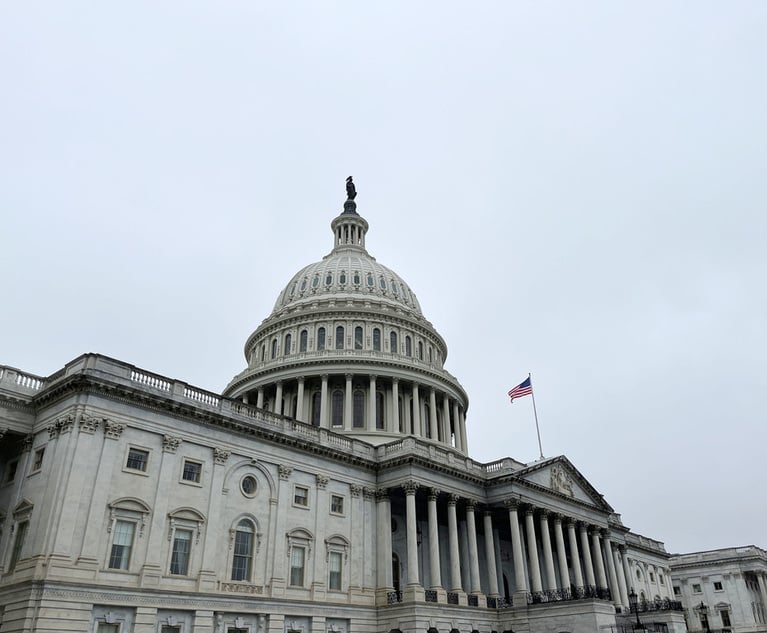Law Firms Took Steps Forward in Diversity in 2018, Not Leaps: Report
Among the findings by the National Association for Legal Placement: Just 4.48 percent of law firm associates were African-American last year.
January 09, 2019 at 01:35 PM
4 minute read
 (Image: Shutterstock.com)
(Image: Shutterstock.com)
A growing percentage of women, minority and LGBT lawyers in law firms nudged legal industry diversity in a positive direction in 2018, but black lawyers and other demographic groups remain underrepresented, according to a new study released Wednesday by the National Association for Legal Placement.
In its annual report on U.S. law firm diversity, NALP found that the representation of minority partners increased by the largest amount in the 26 years the legal employment association has been compiling diversity information at law firms. The NALP study—which draws on race, ethnicity and gender data for more than 109,000 partners and associates, as well as 6,900 summer associates—also pointed to overall increases in the percentage of women among partners at U.S. firms.
Still, the report stressed that those partner level upticks shouldn't be overstated and were “minimal at best.” In 2018, the percentage of minority partners grew 9.13 percent, about a 0.7 percent increase over the 2017 results. Meanwhile, women accounted for 23.36 percent of law firm partners in 2018, up less than a percentage point from 2017.
Diversity at the associate level was also marked by mixed results. NALP reported that women comprised 45.9 percent of law firm associates in 2018. That was less than half a percentage point higher than the 2017 results, but it also pushed women's representation at the associate ranks above a recession-era high recorded in 2009's NALP study.
Representation of minority and minority women lawyers also ticked up slightly in 2018, NALP said, but those gains don't extend to all of the specific demographic groups included in the survey. Specifically, while the representation of Asian and Hispanic associates increased, the percentage of black and African-American associates remains lower than it was in 2009, a year that resulted in widespread layoffs across the law firm world. In 2018, black lawyers made up just 4.48 percent of law firm associates.
NALP's executive director James Leipold described the report's findings as a “good news/bad news story” that shows the law firm world is making small steps toward greater diversity. His comments echoed what he had said in late 2017, the last time NALP issued its diversity report.
“Representation of women associates has finally rebounded and surpassed pre-recession highs for the first time, the jump in the representation of minorities among partners is the largest since NALP began tracking this data, and the number and percentage of LGBT lawyers reached all-time highs,” he said in a statement.
Leipold continued, “On the bad news side, representation of black/African-American associates remains below its pre-recession level, the representation of black/African-American partners has barely changed since the recession, and minority women continue to be the most underrepresented group at the partnership level.”
NALP's study comes on the heels of another recent report that looked at new partners as a gauge for gender diversity in law firms.
In December the Diversity & Flexibility Alliance, a diversity and inclusion think tank that partners with law firms and other employers, released an annual study showing that roughly 39 percent of lawyers promoted to partner in 2018 were women.
While men had a higher promotion rate of just higher than 61 percent, the alliance report also noted that, at 39 percent, the number of women promoted to partner in 2018 outpaces the total percentage of women partners in law firms, according to NALP's latest diversity study results. The alliance's report drew on a smaller sample than NALP's, pulling from the survey responses of 134 law firms.
The diversity alliance also reported that less than one third of the firms surveyed in 2018, or 31.3 percent, had partnership classes that were at least half comprised of women lawyers. That figure is down about two percentage points compared with 2017, but the alliance said it's still a significant increase over historical results.
Read More:
Despite Slight Gains, Study Finds Women and Minorities Still Underrepresented at Law Firms
This content has been archived. It is available through our partners, LexisNexis® and Bloomberg Law.
To view this content, please continue to their sites.
Not a Lexis Subscriber?
Subscribe Now
Not a Bloomberg Law Subscriber?
Subscribe Now
NOT FOR REPRINT
© 2025 ALM Global, LLC, All Rights Reserved. Request academic re-use from www.copyright.com. All other uses, submit a request to [email protected]. For more information visit Asset & Logo Licensing.
You Might Like
View All
'Ridiculously Busy': Several Law Firms Position Themselves as Go-To Experts on Trump’s Executive Orders
5 minute read
Holland & Knight Hires Former Davis Wright Tremaine Managing Partner in Seattle
3 minute read
Am Law 200 Firms Announce Wave of D.C. Hires in White-Collar, Antitrust, Litigation Practices
3 minute read
Paul Hastings Hires Music Industry Practice Chair From Willkie in Los Angeles
Trending Stories
Who Got The Work
J. Brugh Lower of Gibbons has entered an appearance for industrial equipment supplier Devco Corporation in a pending trademark infringement lawsuit. The suit, accusing the defendant of selling knock-off Graco products, was filed Dec. 18 in New Jersey District Court by Rivkin Radler on behalf of Graco Inc. and Graco Minnesota. The case, assigned to U.S. District Judge Zahid N. Quraishi, is 3:24-cv-11294, Graco Inc. et al v. Devco Corporation.
Who Got The Work
Rebecca Maller-Stein and Kent A. Yalowitz of Arnold & Porter Kaye Scholer have entered their appearances for Hanaco Venture Capital and its executives, Lior Prosor and David Frankel, in a pending securities lawsuit. The action, filed on Dec. 24 in New York Southern District Court by Zell, Aron & Co. on behalf of Goldeneye Advisors, accuses the defendants of negligently and fraudulently managing the plaintiff's $1 million investment. The case, assigned to U.S. District Judge Vernon S. Broderick, is 1:24-cv-09918, Goldeneye Advisors, LLC v. Hanaco Venture Capital, Ltd. et al.
Who Got The Work
Attorneys from A&O Shearman has stepped in as defense counsel for Toronto-Dominion Bank and other defendants in a pending securities class action. The suit, filed Dec. 11 in New York Southern District Court by Bleichmar Fonti & Auld, accuses the defendants of concealing the bank's 'pervasive' deficiencies in regards to its compliance with the Bank Secrecy Act and the quality of its anti-money laundering controls. The case, assigned to U.S. District Judge Arun Subramanian, is 1:24-cv-09445, Gonzalez v. The Toronto-Dominion Bank et al.
Who Got The Work
Crown Castle International, a Pennsylvania company providing shared communications infrastructure, has turned to Luke D. Wolf of Gordon Rees Scully Mansukhani to fend off a pending breach-of-contract lawsuit. The court action, filed Nov. 25 in Michigan Eastern District Court by Hooper Hathaway PC on behalf of The Town Residences LLC, accuses Crown Castle of failing to transfer approximately $30,000 in utility payments from T-Mobile in breach of a roof-top lease and assignment agreement. The case, assigned to U.S. District Judge Susan K. Declercq, is 2:24-cv-13131, The Town Residences LLC v. T-Mobile US, Inc. et al.
Who Got The Work
Wilfred P. Coronato and Daniel M. Schwartz of McCarter & English have stepped in as defense counsel to Electrolux Home Products Inc. in a pending product liability lawsuit. The court action, filed Nov. 26 in New York Eastern District Court by Poulos Lopiccolo PC and Nagel Rice LLP on behalf of David Stern, alleges that the defendant's refrigerators’ drawers and shelving repeatedly break and fall apart within months after purchase. The case, assigned to U.S. District Judge Joan M. Azrack, is 2:24-cv-08204, Stern v. Electrolux Home Products, Inc.
Featured Firms
Law Offices of Gary Martin Hays & Associates, P.C.
(470) 294-1674
Law Offices of Mark E. Salomone
(857) 444-6468
Smith & Hassler
(713) 739-1250










